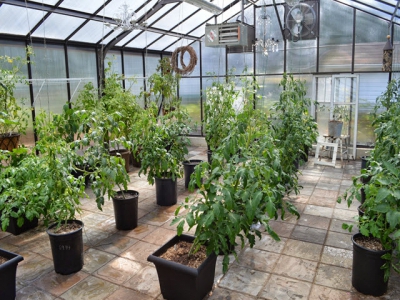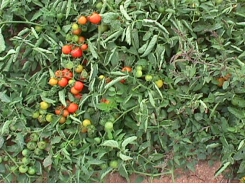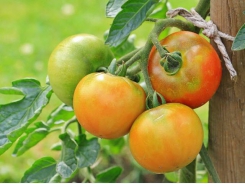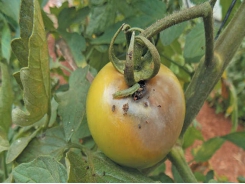Propagation Procedures for Growing Tomatoes

Propagation procedures
Many gardeners prefer to obtain their tomato plants from a nursery for a specific planting time, but there are those who prefer to raise their own, particularly when there are other propagating activities in progress. They should note that initiation of the first and second trusses within the plant takes place at a very early stage of development, long before the trusses are visible. The temperature and light intensity at which this initiation occurs is thought by some research workers and experienced growers to have a profound effect on the ability of the flower to produce fertile pollen and set. Temperature levels also have a considerable effect on the number of flowers on the truss. Satisfactory conditions in these respects must be provided to ensure the production of good plants.
While tomatoes can be propagated vegetatively from 10-13cm (4-5in) cuttings rooted in a peat/sand mix at 18°C (65°F), it is not a practice which has enjoyed any great popularity, due to the risk of virus disease transmission, and also because of the expense of maintaining stock plants throughout the winter months. It is, however, a useful procedure for making up any loss later in the season, simply rooting strong side shoots as they are removed, particularly those from ground-level.
Seed sowing
Sowing can be carried out in a receptacle compatible with the scale of operations, a standard seed tray being suitable for 250-300 seeds and a 13-15cm (5-6in) pot for about 50-60 seeds. (10g of seed produces about 1,000 plants). Use John Innes seed compost, Levington, or peat/sand mixes, which are all suitable; or germinate seeds in a peat/sand mix with lime only added, using liquid feed as soon as germination occurs, thus avoiding possible ammonium damage and subsequent possible damping-off. Space sowing in strip pots, blocks, or in boxes is becoming very popular, especially prior to grafting, and is made simpler by the ready availability of pelleted or pilled seed.
The chosen receptacles are filled with suitably warmed compost, struck off level then pressed down to within 0.6cm (1/4in) of the top. The seed is broadcast thinly (2-3 per sq in) or in 0.3cm (1/8in) drills made with a piece of cardboard, before being covered lightly and gently firmed to keep, if possible, the seed coat below compost level during germination and so avoid the risk of virus infection which occurs when the seed leaves of one plant catch the outside of the seed coat of another. Pelleted seed is sown on the surface and kept moist by covering with polythene. Space sowing in the actual containers, according to some authorities, avoids the check which inevitably occurs during pricking off, but it is not always convenient. When grafting is to be carried out it is advisable to sow the seed of the root stock about 4-5 days before the variety, owing to the slower germination of the former.
Shade boxes or pots, or cover with paper or black polythene (especially pelleted seed). Germination can also be carried out in a germinating cabinet. A germinating day/night temperature of 18°C (65°F) is now accepted as optimal to avoid the predominance of the short jointed non-productive rogues or males which may be induced by higher temperatures.
Pricking off or potting
While there are differences of opinion on the need for early pricking off owing to possible coincidence with truss initiation, it is at present generally accepted that pricking off should take place within 8-12 days of sowing, before roots have developed to any extent. To maintain plants in good condition, especially for the early crop and more particularly if they are to be allowed to flower before planting, a pot size of 12cm (4-1/4in) (or equivalent block size) is generally recommended. Pots may be of clay, plastic, peat or polythene. Blocks should be retained in trays or boxes to avoid disintegration, especially when wet. Dark coloured pots absorb solar radiation better.
The compost for potting is usually John Innes No 1 or soilless potting media. Soilless media tend to give softer plants than those raised in soil-containing media. Less nitrogen would also seem to be required in poor light areas, especially for early raising. The use of supplementary or replacement light is almost standard practice for commercial growers growing early crops of tomatoes, especially in northern areas where natural light can be of low order early in the year. Where plants are raised under artificial lights on capillary watering systems, a very rough sand should be used to give good porosity. Whatever compost is selected, the salt content should not be excessively high, otherwise growth restriction can occur.
Handling seedlings
Except where space sown these are removed from the containers with a tally, carefully holding the leaf tip not the stem, and inserted into half-filled pots; the remaining compost is then pressed around the seedlings. Alternatively they can be inserted into dibber holes sufficiently deep to take the seedling without root restriction. The compost should be firmed by giving a sharp tap on a bench before the seedlings are lightly watered in. Seedlings can also be pricked off into boxes prior to grafting (12-24 per box) in which case the dibber method is used.
Place plants preferably on a slatted type bench with bottom heat, unless soil-warming benches or propagating cases are being utilized.
Temperature levels from pricking off to cropping
Generally speaking, higher temperatures under conditions of good light invariably increase rate of growth and reduce the number of flowers and therefore potential fruit on the bottom truss, although earlier ripening of the fruit is achieved. Conversely lower daytime temperatures will give larger bottom trusses but later development, and this could have some effect on the viability of the pollen. High night temperatures result in taller plants and low night temperatures in squat plants, often with leaves curled upwards; high daytime temperatures in low light intensity areas will induce leggy plants, simply because the plants cannot manufacture sufficient carbohydrates to sustain balanced growth.
Propagation periods involve stages 1 and 2, but generally speaking few gardeners would be able to adhere to the stated temperatures with the same precision as the sophisticated commercial grower, which makes the case for purchasing plants stronger. Compromise overall day/night temperatures in the order of 16°C (60°F) plus or minus a few degrees either way are now general in average gardening circles, ventilating at 21-23°C (70-74°F) under all circumstances.
General care of young plants
Spacing is an essential part of tomato propagation to ensure sturdy well-developed plants with the production of the bottom truss of fruit low down.
Watering should be carried out according to the container and the compost. All-peat composts require less water than more porous peat/sand or soil/sand mixes, peat and paper pots less water than clay or plastic pots, while soil blocks can dry out quickly unless kept close together initially. Peat and paper pots should be kept wider apart than plastic or clay pots to avoid their becoming soggy and disintegrating. It is essential that plants’ water needs are gauged carefully, as either under- or over-watering can have serious consequences. Many gardeners use water at air temperature in preference to tap water, although research has shown that this makes little difference.
Whether to feed young plants or not depends much on the compost, although in general regular feeding is advisable to keep plants growing strongly, particularly in soilless mixes when regular feeding is most certainly always advisable, taking care to avoid the build-up of soluble salts. Either proprietary or self-formulated feeds may be used. Later propagated plants with their quicker development may not need such constant feeding, unless in soilless mixes.
Support with split canes may be required for tall plants which are allowed to flower before planting.
Constant attention to detail is essential for young plants, as any disorder can have serious long-term repercussions.
Production of grafted tomato plants
Root stocks resistant to various maladies are used to overcome weaknesses in the desired variety. These are F1 hybrids and are available as follows:
The current range of rootstocks therefore provides resistance to most common disorders of tomatoes. Remember it is advisable to use ‘Signal’ rootstock when grafting non TMV resistant varieties.
Root stock is generally slower to germinate than the fruiting variety, and should be sown on average 4-5 days earlier. Root stock seed is sown as for the fruiting varieties in trays or in pots and pricked off into boxes at a density of 12-24 per box, the object being to raise sturdy easy-to-graft plants. Grafting is carried out when plants of both the fruiting variety and root stock are about 10-15cm (4-6in) tall and 0.3cm (1/8in) thick, although for inexperienced gardeners the plants may be allowed to become larger.
After removing the seed leaves a downward sloping cut is made in the root stock 1.25-1.8cm (1/2 – 3/4in) long, and a corresponding upward cut is made in the fruiting variety, the tongues then being fitted together and bound up with lead strips or transparent adhesive tape, this being easier if two people are doing the work. The top leaves of the root stock above the graft are then removed and the two plants potted up in a 10-12cm (3-½ — 4-1/4in) pot. Union of the grafts will occur readily on an open bench if the plants are closely spaced, although they can be draped with a polythene ‘tent’ to ensure more humid conditions.
When planting out it is generally advisable for the root of the fruiting variety to be removed to avoid the transmission of various diseases by the non-resistant variety root, although this can result in a severe check to the plants. In most cases the fruiting variety root seldom develops to any extent. Care should be taken to ensure the utmost hygiene during grafting, and it is advisable to dip the blade frequently in a solution of 2% trisodium phosphate or other disinfectant to avoid the spread of virus. Note the new root stock T. M. P. V. F2. N. and ask for this.
The time and trouble involved in grafting, or alternatively the high cost of purchasing plants at nearly twice the price of normal plants, must be weighed carefully against alternative cultural systems involving clean media.
Có thể bạn quan tâm
Phần mềm

Phối trộn thức ăn chăn nuôi

Pha dung dịch thủy canh

Định mức cho tôm ăn

Phối trộn phân bón NPK

Xác định tỷ lệ tôm sống

Chuyển đổi đơn vị phân bón

Xác định công suất sục khí

Chuyển đổi đơn vị tôm

Tính diện tích nhà kính

Tính thể tích ao hồ




 Beware the thrips threat!
Beware the thrips threat!  Controlling the African bollworm
Controlling the African bollworm